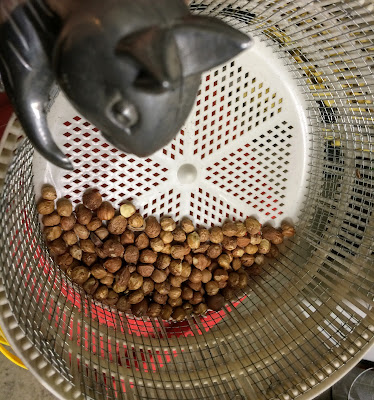Looking at the orchard from a drone
Taken by Bryce Johnson
After clearing most of the dead elms, buckthorn, and a couple boxelders, it opened up most of the northern part of the area. In the wooden fence on the upper left corner I planted cottonwood, bur oak, silver maple, spruce, black walnut, hazelnut, and amur maple. I'm hoping by next year the trees will start blocking that cold north wind. The fenced in area is where I plant most of the newer hazelnuts plantings. In the lower left hand corner are older plants outside the deer fence, which are subjected to the deer and rabbits.
These are the hazelnut plants outside the fence. The plant on the far left has most of the bark rubbed off from a deer and by spring the rabbits will have eaten off most of the smaller immature stems.
This is a close up of that same plant outside the fence that the deer rubbed the bark off. Most stems like this will leaf out in the spring, but this one will have to be pruned out to help eliminate any diseases that might infected the plant like EFB(Eastern Filbert Blight). Because hazelnuts are a multistem plant, it will not affect the main plant, but you will loose some nut production.
This is another plant outside the fence that the deer decided to rub. I was going to prune this plant next spring down to 4 or 5 stems and he tore up the one stem I planned on keeping.
This is one more hazelnut plant that was done in by a deer.
These are some of my 3 and 4 year old potted hazelnut plants that I keep behind a fence away from hungry rabbits and deer. The plants here are covered with wood chips and snow, so they should be ready for another winter.
These are the 1 and 2 year old potted hazelnut plants, which should be ready for sale in the spring.
This is my buddy Al (aluminum nut cracking squirrel) who is showing nuts from several different hazelnuts ready to be processed.
The first step in the process is to sort the nuts by size. As you can see Al is inspecting the hoppers under the sorter. The slat spacings on the drum are 1/4 inch on the feed side and 1 inch on the other side.
In this picture Al is watching the drum turning as the nuts fall into the different hoppers.
Al is now inspecting the different sized nuts in the hoppers.
This is the drill powered nut cracker I use for cracking the hazelnuts.
Right above Al's head is the adjustment for the different sized nuts.
I first adjust it to crack the largest nuts, then turn the adjustment 1/4 turn in for each size.
I've found by doing it this way the shell will crack leaving the meats (kernel) whole.
Al is showing us the cracked hazelnuts after they've gone through the cracker.
This is a close-up of the cracked nuts. If you look closely some of the meats are broken.
The next step in the process is separating meats from the shell. I use an aspiration system that I made from PVC pipes, shop vac, and a few 2 inch flex hoses.
In this process the material is sucked up into the first column and the lighter material moves all the way to the top and into the second column, while the heavy meats fall to the bottom of the first column.
Can you find Al in this picture?
In this picture the cracked nuts are being vacuumed up into the first column.
For the best results of separation Al is showing us that a vacuum should be about 11 inches wc
Al is inspecting the clean and separated meats (kernels).
I placed a ruler in the basket to show the size of the kernels.
If you look close there are a few shells left and one whole nut that will be picked out by hand.
Al is now looking through the shells for whole or broken kernels after they have gone through the aspiration system.
I was informed by my daughter that they use hazelnut shells for mulch around plants in Oregon. I'll have to try it here around some of my plants
I wanted to show this picture of Nancy and I standing in front of one of the better hazelnut plants.
This is also one of the plants the deer picked to rub off most of the bark on two stems.😠

















































